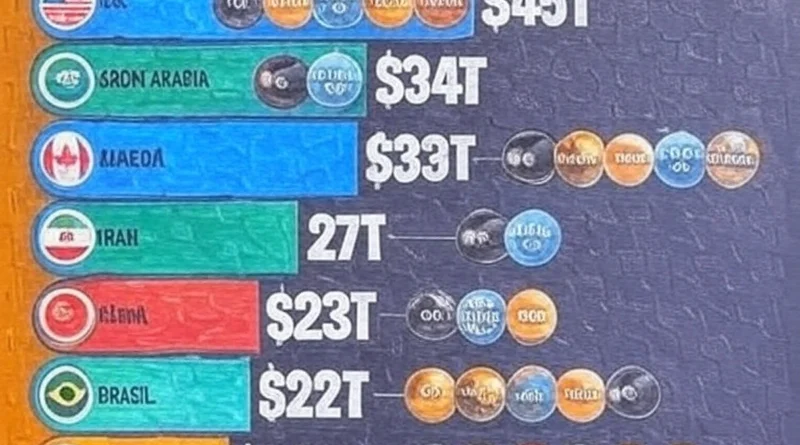The world’s richest country in terms of natural resources
Natural resources are the backbone of many economies, fueling industries, powering nations, and shaping global trade. In 2021, Statista released data, visualized by Elements Visual Capitalist, ranking the top 10 countries by the estimated value of their natural resources. These figures, rounded to the nearest trillion dollars, highlight the immense wealth embedded in the Earth’s reserves and the strategic importance of resource-rich nations. Let’s dive into the rankings and explore what these numbers reveal about global resource distribution.
1. Russia – $75 Trillion
Topping the list is Russia, with an staggering $75 trillion in natural resource value. Russia’s vast landscape, spanning 17 million square kilometers, is a treasure trove of resources. Its primary assets include coal, natural gas, oil, timber, and rare earth metals. Russia holds some of the world’s largest natural gas reserves, particularly in Siberia, and is a leading oil producer. The country’s timber resources, drawn from the expansive taiga forests, and its deposits of rare earth metals, critical for technology manufacturing, further bolster its position. This immense resource wealth makes Russia a key player in global energy markets, though geopolitical tensions often complicate its role.
2. United States – $45 Trillion
The United States follows with $45 trillion in natural resources. The U.S. benefits from a diverse resource base, including coal, timber, natural gas, gold, and copper. The country’s coal reserves, primarily in states like Wyoming and West Virginia, have historically powered its industrial growth. Natural gas, especially from shale formations, has surged in production over the past decade, making the U.S. a net exporter. Timber from the Pacific Northwest, gold from Nevada, and copper from Arizona add to its wealth. The U.S.’s ability to extract and utilize these resources domestically gives it significant economic leverage, though environmental concerns and the shift toward renewable energy are reshaping its resource strategy.
3. Saudi Arabia – $34 Trillion
Saudi Arabia ranks third with $34 trillion, driven almost entirely by its oil and natural gas reserves. The kingdom sits atop the world’s second-largest proven oil reserves, primarily in the Eastern Province, including the massive Ghawar Field. Oil has been the cornerstone of Saudi Arabia’s economy for decades, funding its modernization and global influence through OPEC. Natural gas, though less dominant, is increasingly important as the country diversifies its energy sector. Saudi Arabia’s resource wealth underscores its pivotal role in global energy markets, but it also faces challenges as the world transitions to cleaner energy sources.
4. Canada – $33 Trillion
Canada, with $33 trillion in natural resources, is a resource powerhouse in North America. Its key assets include oil, uranium, timber, natural gas, and phosphate. The oil sands in Alberta are a major contributor, though their extraction is energy-intensive and controversial due to environmental impacts. Canada is also a leading producer of uranium, vital for nuclear energy, with deposits in Saskatchewan. The country’s vast forests provide timber, while natural gas and phosphate—used in fertilizers—round out its portfolio. Canada’s resource wealth supports its economy, but sustainable management remains a priority amid climate change concerns.
5. Iran – $27 Trillion
Iran’s natural resources are valued at $27 trillion, primarily from oil and natural gas. The country holds the world’s fourth-largest oil reserves and the second-largest natural gas reserves, much of which are in the South Pars/North Dome field shared with Qatar. Iran’s energy resources give it significant geopolitical influence, particularly in the Middle East, but international sanctions and political instability have hindered its ability to fully capitalize on this wealth. Despite these challenges, Iran remains a critical player in global energy dynamics.
6. China – $23 Trillion
China’s $23 trillion in natural resources reflects its vast and varied reserves, including coal, rare earth metals, and timber. China is the world’s largest coal producer, fueling its massive industrial sector, though this reliance has led to significant environmental issues. The country dominates the global supply of rare earth metals—essential for electronics, renewable energy technologies, and defense systems—with major deposits in Inner Mongolia. Timber from China’s forests also contributes, though deforestation has prompted stricter regulations. China’s resource wealth supports its manufacturing-driven economy, but it also highlights the tension between economic growth and environmental sustainability.
7. Brazil – $22 Trillion
Brazil, with $22 trillion in natural resources, benefits from a diverse portfolio that includes gold, uranium, iron, timber, and oil. The Amazon rainforest, often called the “lungs of the Earth,” provides vast timber resources, though deforestation has sparked global concern. Brazil is a leading producer of iron ore, primarily from the Carajás Mine, and has significant gold and uranium deposits. Offshore oil fields, like those in the Santos Basin, have also boosted its resource value. Brazil’s natural wealth is a double-edged sword, offering economic opportunities while posing environmental and social challenges.
8. Australia – $20 Trillion
Australia’s $20 trillion in natural resources includes coal, timber, copper, iron, gold, and uranium. The country is a top exporter of coal and iron ore, with major operations in Western Australia and Queensland. Copper and gold mining, particularly in regions like the Pilbara, are also significant. Australia’s uranium reserves, the world’s largest, are a key asset for nuclear energy markets. Timber from its forests adds to the mix. Australia’s resource-driven economy benefits from strong global demand, particularly from Asia, but it must balance extraction with environmental stewardship.
9. Iraq – $16 Trillion
Iraq’s $16 trillion in natural resources is largely tied to oil and phosphate. The country holds the world’s fifth-largest proven oil reserves, concentrated in the south around Basra. Oil accounts for the vast majority of Iraq’s export revenue, making it heavily dependent on global oil prices. Phosphate, used in fertilizers, is another valuable resource, with deposits in the western desert. Iraq’s resource wealth offers immense potential, but decades of conflict, political instability, and infrastructure challenges have limited its ability to fully harness these assets.
10. Venezuela – $14 Trillion
Rounding out the list is Venezuela, with $14 trillion in natural resources, primarily iron, natural gas, and oil. Venezuela boasts the world’s largest proven oil reserves, surpassing even Saudi Arabia, with much of it in the Orinoco Belt. However, economic mismanagement, political turmoil, and sanctions have crippled its oil industry. Natural gas and iron ore, including deposits in the Guiana Highlands, add to its resource base. Venezuela’s vast wealth stands in stark contrast to its economic struggles, highlighting the challenges of translating natural resources into sustainable development.



